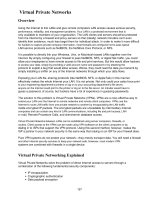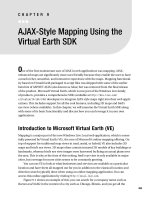Virtual Switch Controller
Bạn đang xem bản rút gọn của tài liệu. Xem và tải ngay bản đầy đủ của tài liệu tại đây (369.79 KB, 14 trang )
Chapter 13. Virtual Switch Controller
This chapter focuses on Cisco's Virtual Switch Controller (VSC), which is a key architectural component of the
virtual switch. The concept of a virtual switch is based on today's voice networks moving from a time-division
multiplexing (TDM) infrastructure to a new packet-based, voice service infrastructure. This new infrastructure
consists of the following distributed network elements:
• Media gateways (MGs)
• Packet networks
• Signaling, services, and call control
• Service provisioning and management
The collection of these elements constitutes a virtual switch where intercommunication is accomplished using
open and standards-based protocols. Cisco's VSC provides the virtual switch's call-control functions. Drawing
upon analogies of existing TDM switches, the VSC implements the functions of the software components
found in a Service Switching Point (SSP). Other VSC-equivalent terms include Media Gateway Controller
(MGC), call agent, soft-switch, and software-based SSP.
Overview of the Virtual Switch
The virtual-switch concept evolves the current paradigm of TDM switches into a distributed architecture. This
concept is realized through the use of the:
• Packet-based multiservice access methods, equivalent to Public Switched Telephone Network (PSTN)
line cards
• Distributed packet-bearer switching networks, analogous to TDM switch fabric
• Call-control servers such as VSC, analogous to SSP functionality
In addition to functions commonly found in a traditional SSP, however, the VSC adds additional capabilities
that cater to applications such as H.323 and Session Initiation Protocol (SIP). The VSC operates in a UNIX
environment with the goal of providing customers a high degree of open interfaces and programmability.
Cisco's realization of the virtual switch is a component of the Cisco Open Packet Telephony (OPT)
architecture.
Open Packet Telephony
Cisco's Open Packet Telephony (OPT) architecture is based upon the creation of three logical planes:
connection control, call control, and services. Each plane represents a different functional aspect of a voice
service and interacts with the other logical planes through well-defined open interfaces. The three planes are
organized into a hierarchy, with connection control at the lowest level, call control above connection control,
and services above call control. Figure 13-1
illustrates the functional composition of the OPT architecture.
201
Figure 13-1. Open Packet Telephony Architecture
The VSC provides the following call control-plane functions in the Cisco OPT architecture (in the Media
Gateway Control Protocol [MGCP] architecture, the VSC represents the MGC):
• The connection or bearer control plane encompasses the functionality necessary to set up, maintain,
and tear down voice paths through the packet network. Existing Cisco AS5300, MGX8850 and 8260,
2600, 3600, 3810, and uBR924 are known as MGs. The connection control plane communicates with
the call-control plane using an industry-standard control protocol such as Simple Gateway Control
Protocol (SGCP) or MGCP.
• The call-control plane comprises the functionality necessary to signal, process, and route voice and
data calls over the packet network. Functions within this layer are close to those found in the call-
processing logic of an existing TDM switch. Typical call control-plane functions include Signaling
System 7 (SS7) protocol processing, digit analysis and manipulation, route selection, hunting, switch-
based features, and interfacing with external service logic programs.
The call-control plane communicates with the connection control plane using MGCP or SGCP. The
architectural intent of this interface is to cleanly separate the connection control from the call control in
such a way that the call-control plane is independent (and unknowing) of the underlying voice packet
transport. This enables the same call-control plane to be used with either a Layer 3 (Internet Protocol
[IP]) or Layer 2 (Asynchronous Transfer Mode/Frame Relay [ATM/FR])-oriented MG.
The call-control layer also communicates with the service plane to provide flexible, enhanced services.
This interface is typically a standards-based Intelligent Network (IN) protocol running over SS7
transaction capabilities application part (TCAP), although many additional vendor-proprietary variants
and extensions exist.
• The service plane encompasses the logic necessary to provide enhanced nonswitch-resident services.
You can accomplish such functions with Service Control Points (SCPs) or service nodes. When using
SCPs, the call-control plane signals the SCP using the Advanced Intelligent Network (AIN) or IN
protocol over SS7 TCAP. Typical SCP applications include number translation (800#), account code
authentication, credit card validation, and Virtual Private Network (VPN).
When using Service Nodes, the VSC typically routes a call to the Service Node for processing. The
service node then applies its own feature-specific treatment to the voice or data stream and completes
call routing to the intended destination. Depending upon the feature, the service node can either
remain in the path of the call or give control of the call back to the VSC. Typical service node
applications include voice mail, debit card, and voice-activated dialing.
202
Packet Voice Network Overview
VSC provides call-control capability for the next-generation network. It controls how narrowband TDM voice
traffic is consolidated over the packet infrastructure, and ways you can apply services to those calls. You can
use the VSC in a variety of applications to provide call-control functions. Examples of applications enabled on
the packet voice network architecture include the following:
• Packet voice inter-exchange carrier (IXC) tandem applications
• Packet voice Local Exchange Carrier (LEC) Class 4 relief applications
• Endpoint client multimedia applications
• Corporate voice on-net and off-net services
• Voice over IP (VoIP) local/end office applications on cable infrastructure
Figure 13-2
depicts a generic packet voice application and illustrates various architectural components as
well as how they fit and interact with each other.
Figure 13-2. Packet Voice Network Architecture
Network Elements
This section reviews each network element identified in Figure 13-2. These elements include the following:
• VSC
• MG
• SCP
• Service node
• Cable head end
• Residential gateway
• H.323 endpoint/client
Virtual Switch Controller
At a high level, the virtual switch controller (VSC) provides the following core capabilities:
203
• Call-signal processing including Integrated Services Digital Network (ISDN) Level 3 (Q.931), SS7
Level 4 (ISDN User Part [ISUP]), H.323, and Multi-Frequency/channel-associated signaling (MF/CAS),
as well as call signaling toward devices located at residential gateways connected through cable or
digital subscriber line (DSL) Customer Premise Equipment (CPE); also includes the capability to
translate between different signaling types on different call legs
• Address resolution, call routing, resource management, connection control, and Call Detail Record
(CDR) generation
• Service access functions for accessing services executing on external server platforms (such as SCP
or Service node)
• Management interfaces using Simple Network Management Protocol (SNMP) for faults, performance,
and configuration; Web-based configuration tool and element management system
Media Gateway
Media Gateway (MG) performs the following high-level functions:
• Physical T1/E1 TDM facility termination from the PSTN or Private Branch eXchanges (PBXs)
• Communication with the VSC for call setup and teardown using SGCP or MGCP
• Echo cancellation into the circuit-switched network
• Balancing the jitter buffers
• Voice activity detection (VAD), such as silence suppression and comfort noise regeneration
• Voice compression using International Telecommunication Union (ITU) recommendations such as
G.711, G.723.1, and G.729
• Tone generation, which generates dial, busy, ring-back, and congestion tones
• Dual-Tone Multi-Frequency (DTMF) transport, which enables use of touch tones for voice mail
applications with codecs that support DTMF detection/transport
• µ-law and a-law transcoding when required
• Quality of service (QoS) support
Service Control Point
The SCP provides the execution environment for service logic. The SCP is responsible for processing
transaction requests and returning a response. A typical transaction request in the voice world is a number
translation.
Examples of this service include 800 (toll-free) service and Local Number Portability (LNP). A toll-free
application running on the SCP, for example, has a sophisticated logic that enables the end user to control
how incoming calls are routed. You can base toll-free call routing on dialed number, time of day, day of week,
geographic point of origination, and even on how busy a terminating automatic call distribution (ACD) might be
at a given moment. Customers or the service provider (SP) can own the SCP.
Service Node
The service node component of Cisco's voice architecture is realized by Cisco's open, programmable switch of
the VCO. The VCO/4k is modular and scalable. It incorporates compatible generic software, universal network
interfaces, and service resources and employs advanced technologies such as SS7, ISDN, hierarchical call
control, and SNMP network management. In addition, the VCO/4k are Central Office (CO)-compliant, and you
can deploy them in fully redundant or nonredundant environments.
Cable Head End
The Universal Broadband Router is an integrated cable modem termination system (CMTS) and Cisco 7200
series router utilizing radio frequency (RF) line cards. The Universal Broadband Router provides a single
integrated solution with CMTS functionality, the capability to terminate the Data-over-Cable Service Interface
Specifications (DOCSIS) protocol, and the capability to perform all the data routing functions required.
Instantiation of this component also includes a Digital Subscriber Line Multiplexer (DSLAM).
204
Residential Gateway
The residential gateway is a voice/data CPE device that provides from two to four ports of plain old telephone
service (POTS) capability. The device runs the DOCSIS protocol to provide packet data and telephony
services over the hybrid fiber-coaxial (HFC) cable to the CMTS. Another example of this component also
includes a DSL modem.
H.323 Endpoint/Client
The H.323 client represents a broad range of voice/multimedia applications that are hosted natively on the IP
network. The H.323 endpoint is covered in detail in Chapter 10, "H.323."
Network Interfaces
The four main VSC network interfaces are signaling termination, inter-VSC signaling, connection control, and
services control, as illustrated in Figure 13-3
.
Figure 13-3. Network Interfaces
Each VSC network interface is discussed in the following sections.
Signaling Termination
The signaling termination capability enables the VSC to mediate between many signaling variants, such as
SS7, Primary Rate Interface (PRI), CAS, and H.323, to name a few.
SS7 Links
Several mechanisms are available to terminate SS7 signaling traffic on the VSC:
• Nonassociated signaling (A-links)—Terminated directly on the VSC using either a V.35 or T1/E1
physical interface. Optionally, to increase reliability characteristics, you can configure a set of
Signaling Link Terminals (SLTs) to handle the lower layers of SS7. The SLTs are implemented using
Cisco 2600 series routers fronting Sun servers that host the VSC application.
• Fully associated signaling (F-links)—Carry bearer traffic and are terminated on the packet gateway.
The packet gateway is responsible for executing Message Transfer Parts (MTPs) 1 and 2,
205









